Shareholder Value Maximization - The World’s Dumbest Idea?
InvestorEducation / Learning to Invest Dec 05, 2014 - 05:49 PM GMTBy: John_Mauldin
 In today’s Outside the Box the redoubtable James Montier of GMO lifts his lance to prick the underbelly of the Mighty SVM. (That’s Shareholder Value Maximization, for you newbies.) “The world’s dumbest idea” (among many candidates in the world of finance), says James, citing none other than “Neutron Jack” Welch in support.
In today’s Outside the Box the redoubtable James Montier of GMO lifts his lance to prick the underbelly of the Mighty SVM. (That’s Shareholder Value Maximization, for you newbies.) “The world’s dumbest idea” (among many candidates in the world of finance), says James, citing none other than “Neutron Jack” Welch in support.
After noting that taking on SVM “is a little like criticizing motherhood and apple pie,” James sets right to work, tracing the monster’s birth to an editorial by Milton Friedman in 1970, in which Saint Milton wrote, “There is one and only one social responsibility of business – to use its resources and engage in activities designed to increase its profits...”
Our intrepid author then explains how in the 1970s the Gospel According to Milton translated into the challenge of how to get corporate executives to focus on maximizing the wealth of shareholders. The solution: pay them a s***load of money (but not just cash – stock and options now constitute about two-thirds of total CEO compensation).
But, alas, there is pretty good research to suggest that larger incentives actually translate to lower performance, for reasons that James runs down for us. To make matters worse, both the average tenure of a corporate CEO and the average lifetime of an S&P 500 company have plummeted since the 1970s.
Bottom line: SVM has pretty well laid the kingdom to waste. James focuses on three areas of damage: (1) declining and low rates of business investment, (2) rising inequality, and (3) a low labor share of GDP. James takes these outcomes on one at a time, in his usual convincing manner. (Other work by James and some of the brightest minds around can be found at www.gmo.com.)
Last night there was a small dinner/reception/fundraiser at Harland and Amy Korenvaes’ home for the foundation of Ayaan Hirsi Ali. Ayaan wrote the books Infidel and Nomad, detailing her journey from Somalia, where as a young girl she actually joined the Muslim Brotherhood. (That’s what her family and all her friends did. When she started asking questions, it became a problem. She was told that girls simply did as they were told.) She ended up fleeing to Europe and went on to become a member of the Dutch parliament (one of the great political twists of all time) and an outspoken advocate of Islamic women’s rights. For those not familiar, she was integral (as in, provided the outline and ideas) for Theo van Gogh’s movie outlining the problems that some Islamic young women have in the parts of Muslim society that considers them property.
This past November was the 10th anniversary of the murder of van Gogh on the streets of Amsterdam by an Islamic radical, who considered the movie an affront to his religion, a transgression that called for the death of anyone involved. Ayaan has lived with death threats for over 20 years now. She is accompanied by serious security everywhere she goes. I’ve actually gotten to know some of her security detail over time. Talk with Ayaan and her husband, Niall Ferguson, about the constraints imposed upon them by the constant worry that at any moment she could be attacked, and you are introduced to another world.
Niall, too, is outspoken. But thankfully, being a forceful critic of neo-Keynesianism merely gets you vilified by Paul Krugman. I didn’t even need security when I went to Japan a few years ago and told them their debt problem was going to create a significant crisis and the yen was toast. (The yen was close to its all-time high at that point.)
The majority of the people around the dinner table last night were women, and the evening was designed to stimulate free-flowing conversation, so it was interesting to observe the kinds of questions people asked of Ayaan. While everyone in the room (other than your humble analyst) would’ve been in the upper reaches of the 1%, they came from varied backgrounds. Yet there was clearly somewhat of a struggle to understand the depth of oppression and desperation in the world Ayaan came from.
If you are a young girl in a very closed culture and are told certain facts by your parents and your religious authorities and all your neighbors, then what can you do if you see that those facts don’t square with actions? How can Islam be a religion of peace with ISIS and Boko Haram beheading people simply because they believe differently? Why would you, as a girl, not be allowed the same rights as your brothers? What is the true line between belief and practice?
There is a part of the world where honor killings, genital mutilation, beatings, forced marriages of girls under 15, and so on are common practice. That world was so far removed from our Dallas table, and yet Ayaan’s story moved everyone in the room.
As you consider your Christmas giving, why not take some time to read Ayaan’s books, get to know her through her work, and then consider a donation to help her help other girls growing up as she did. You can make a donation at her foundation’s website, http://theahafoundation.org/. I can think of nothing that is more in the spirit of the season than helping those who can’t help themselves.
Before I close, I want to mention that Jack Rivkin (CIO of Altregris) and I are going to be interviewing Ian Bremmer next Tuesday. We’ll be talking about the geopolitical situation all over the world and how it will affect our investments. I hope to steer the conversation to what is happening in Russia and the Middle East, with of course a nod to China; but we’ll see what Jack and Ian want to talk about. My goal is for listeners to walk away with greater clarity about the changing geopolitical landscape and an actionable perspective on global markets and the potential for diversifying investment alternatives in 2015. If you are a member of the Mauldin Circle, you should have already received an invitation. Otherwise, if you would like information on how to gain access, see below.
Have a great week.
Your thinking the Christmas tree goes up this week analyst,
John Mauldin, Editor
Outside the Boxsubscribers@mauldineconomics.com
If you are an accredited investor or a FINRA-licensed advisor, please join me for an exclusive Mauldin Circle webinar on Tuesday, December 9, at 12:30 p.m. EST/9:30 a.m. PST. This highly anticipated webinar, “Navigating a Changing Global Landscape: What Investors Need to Know for 2015,” will provide a timely perspective for investors making 2015 portfolio decisions. I’ve invited my friend Ian Bremmer, President of Eurasia Group, and Altegris CIO Jack Rivkin to join me. These two leading minds will provide a terrific mix of economic and investment viewpoints, with a bent towards examining the impact of global events on investment decisions.
If you are a Mauldin Circle member, a webinar invitation will be sent directly to you by email. A replay will also be available to qualified registrants. If you are unable to listen in to the live discussion, be sure to register so that you can receive the replay information. If you are not a member of the Mauldin Circle and are an accredited investor or a FINRA-licensed advisor, please join today. The Mauldin Circle program provides exclusive access to alternative investment managers and other thought leaders. In addition, members receive access to special events and conferences. Upon qualification by my partners at Altegris, you will receive an email invitation. I apologize for limiting this discussion to accredited investors and investment advisors, but we must follow the rules and regulations. I look forward to having you at this special Mauldin Circle event. (In this regard, I am president and a registered representative of Millennium Wave Securities, LLC, member FINRA.)
The World’s Dumbest Idea
By James Montier
GMO White Paper, Dec. 2104
When it comes to bad ideas, finance certainly offers up an embarrassment of riches – CAPM, Efficient Market Hypothesis, Beta, VaR, portfolio insurance, tail risk hedging, smart beta, leverage, structured finance products, benchmarks, hedge funds, risk premia, and risk parity to name but a few. Whilst I have expressed my ire at these concepts and poured scorn upon many of these ideas over the years, they aren’t the topic of this paper.
Rather in this essay I want to explore the problems that surround the concept of shareholder value and its maximization. I’m aware that expressing skepticism over this topic is a little like criticizing motherhood and apple pie. I grew up in the U.K. watching a wonderful comedian named Kenny Everett. Amongst his many comic creations was a U.S. Army general whose solution to those who “didn’t like Apple Pie on Sundays, and didn’t love their mothers” was “to round them up, put them in a field, and bomb the bastards,” so it is with no small amount of trepidation that I embark on this critique.
Before you dismiss me as a raving “red under the bed,” you might be surprised to know that I am not alone in questioning the mantra of shareholder value maximization. Indeed the title of this essay is taken from a direct quotation from none other than that stalwart of the capitalist system, Jack Welch. In an interview in the Financial Times from March 2009, Welch said “Shareholder value is the dumbest idea in the world.”
A Brief History of a Bad Idea
Before we turn to exploring the evidence that shareholder value maximization (SVM) has been an unmitigated failure and contributed to some very undesirable economic outcomes, let’s spend a few minutes tracing the intellectual heritage of this bad idea.
From a theoretical perspective, SVM may well have its roots in the work of Arrow-Debreu (in the late 1950s/early 1960s). These authors demonstrated that in the presence of ubiquitous perfect competition and fully complete markets (neither of which assumption bears any resemblance to the real world, of course – break these assumptions and you break the link between SVM and social welfare; but trivial details like the critical realism of assumptions never seem to bother the average economist) a Pareto optimal outcome will result from situations where producers and all other economic actors pursue their own interests. Adam Smith’s invisible hand in mathematically obtuse fashion.
However, more often the SVM movement is traced to an editorial by Milton Friedman in 1970. Given Friedman’s loathing of all things Keynesian, there is a certain delicious irony that the corporate world is so perfectly illustrating Keynes’ warning of being a slave of a defunct economist! In the article Friedman argues that “There is one and only one social responsibility of business – to use its resources and engage in activities designed to increase its profits...”
(It is quite staggering just how many bad ideas in economics appear to stem from Milton Friedman. Not only is he culpable in the development of SVM, but also for the promotion of that most facile theory of inflation known as the quantity theory of money. Most egregiously of all, he is the father of the doctrine of the “instrumentalist” view of economics, which includes the belief that a model should not be judged by its assumptions but by its predictions.)
Friedman argues that corporates are not “persons,” but the law would disagree: firms may not be people but they are “persons” in as much as they have a separate legal status (a point made forcefully by Lynn Stout in her book, The Shareholder Value Myth). He also assumes that shareholders want to maximize profits, and considers any act of corporate social responsibility an act of taxation without representation – these assumptions may or may not be true, but Friedman simply asserts them, and comes dangerously close to making his argument tautological.
Following on from Friedman’s efforts, along came Jensen and Meckling in 1976. They argued that the key challenge when it came to corporate governance was one of agency theory – effectively how to get executives (agents) to focus on maximizing the wealth of the shareholders (principals). This idea can be traced all the way back to Adam Smith in The Wealth of Nations (1776) where he wrote:
The directors of such [joint stock] companies, however, being the managers rather of other people’s money than of their own, it cannot well be expected that they should watch over it with the same anxious vigilance with which the partners in a private copartnery frequently watch over their own. Like the stewards of a rich man, they are apt to consider attention to small matters as not for their master’s honour, and very easily give them a dispensation from having it. Negligence and profusion, therefore, must always prevail, more or less, in the management of the affairs of such a company.
Under an “efficient” market, the current share price is the best estimate of the expected future cash flows (intrinsic worth) of a company, so combining EMH with Jensen and Meckling led to the idea that agents could be considered to be maximizing the principals’ wealth if they maximized the stock price.
This eventually led to the idea that in order to align managers with shareholders they need to be paid in a similar fashion. As Jensen and Murphy (1990) wrote, “On average, corporate America pays its most important leaders like bureaucrats.” They argued that “Monetary compensation and stock ownership remain the most effective tools for aligning executive and shareholder interests. Until directors recognize the importance of incentives and adopt compensation systems that truly link pay and performance, large companies and their shareholders will continue to suffer from poor performance.”
Widespread Adoption of the Bad Idea
So far we have traced only the rise of SVM amongst academics and, frankly, who cares what a bunch of academics think? Of considerably more concern is the evidence that the tenet of SVM has become conventional wisdom (an oxymoron if ever there was one) amongst those who inhabit the real world. For instance, take a look at the statements issued by the Business Roundtable (an association of CEOs of leading U.S. companies). In 1981 they stated, “Corporations have a responsibility, first of all, to make available to the public quality goods and services at fair prices, thereby earning a profit that attracts investment...provide jobs, and build the economy.”
By 1997, this concern for the role of the corporation at large had transmuted into a single-minded focus on SVM as represented by the following edict: “The principal objective of a business...is to generate economic returns to its owners...if the CEO and the directors are not focused on shareholder value, it may be less likely the corporation will realize that value.”
In many ways that bluest of blue chips, IBM, represents a perfect microcosm of the general pattern of obsession with SVM. Cast your eyes over Exhibit 1. It charts the total returns to an investor in IBM since 1973. In those early days, IBM’s mission statement was outlined by Tony Watson (the son of the founder) and was based on three principles (in descending order of importance): 1) respect for individual employees; 2) a commitment to customer service; and 3) achieving excellence.
By the early 1990s, IBM had pretty much been flat in total nominal return terms since the 1970s. Lou Gerstner arrived as CEO and stated, “Our primary measures of success are customer satisfaction and shareholder value.” In their Roadmap 2010, under Samuel Palmisano, the goal shifted to the primary aim of doubling earnings per share over the next five years!
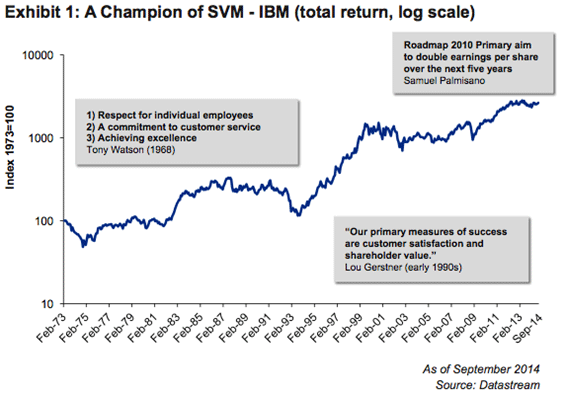
One might be tempted to conclude that the evidence offered by IBM strongly supports the power of SVM. After all, after languishing for a prolonged period, when Gerstner and his focus on SVM arrived on the scene IBM enjoyed a significant revival. However, before you conclude I’ve shot myself in the foot by showing this example, take a look at Exhibit 2, which compares the SVM champion IBM with a company with an altogether different perspective, Johnson & Johnson.
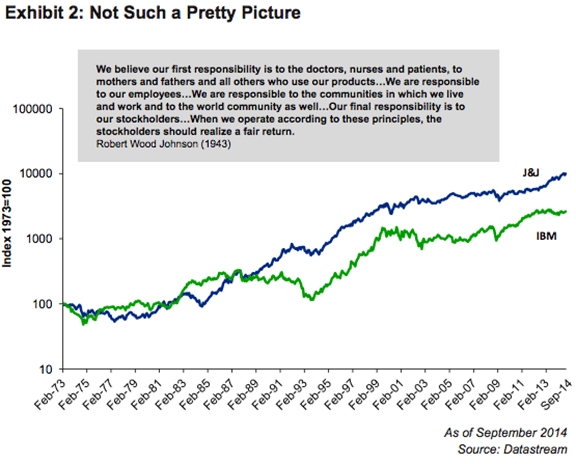
In contrast to IBM’s transient objectives, Johnson & Johnson has stuck with a mission statement written by its founder (Robert Wood Johnson) as part of its IPO documentation in 1943, which reads as follows: “We believe our first responsibility is to the doctors, nurses and patients, to mothers and fathers and all others who use our products...We are responsible to our employees...We are responsible to the communities in which we live and to the world community as well...Our final responsibility is to our stockholders...When we operate according to these principles, the stockholders should realize a fair return.”
The contrast between the two firms couldn’t be much greater. Whilst IBM targeted SVM, Johnson & Johnson thought shareholders should get a “fair return.” Yet, Johnson & Johnson has delivered considerably more return to shareholders than IBM has managed over the same time period.
Prima Facie Case Against SVM
To move from the micro to the macro, we can contrast the returns achieved by shareholders in the era of managerialism (defined here as 1940-90, although the results are robust to the exact sample chosen) with those achieved in the era of SVM (1990-2014). Exhibit 3 shows the results of this comparison in two different ways. The first pair of bars shows the total real returns (p.a.) in the two periods. They are virtually identical (the era of managerialism actually produced slightly higher real returns). So much for the horror that was visited upon investors by this experience.
The second set of bars adjusts the total real return data to account for shifts in valuation, which effectively have nothing to do with the underlying return generation of companies, but rather reflect the price that the market is willing to put upon those returns. As you can see, the adjustment barely impacts the returns achieved during the era of managerialism. However, a significant proportion of the returns achieved in the era of SVM actually came from the price investors were willing to pay. If we remove this element, then the underlying return generation of companies has fallen significantly under SVM.
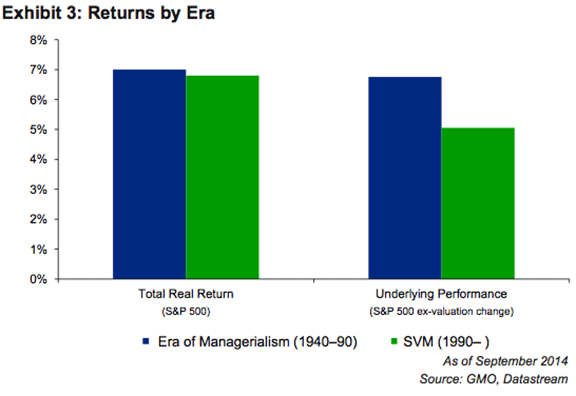
What Went Wrong?
Given this data, the natural follow-on question is, of course, what went wrong? I think one of the most obvious candidates concerns the pay of CEOs. When one casts even a cursory glance over Exhibit 4 (CEO median pay) the increasing dominance of stock-related pay becomes obvious. During the era of managerialsim, the vast majority (i.e., over 90%) of the total compensation for CEOs came through salary and bonus. In the last two decades one can see the increasing dominance of stock-related pay. In the last decade some two-thirds of total CEO compensation has come through stock and options.
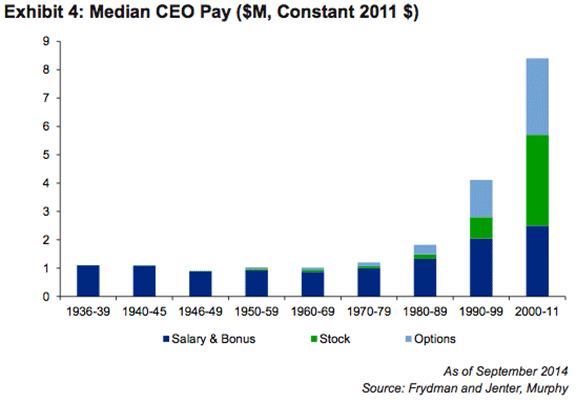
This has certainly aligned managers and shareholders à la Jensen and Murphy, but doesn’t seem to have generated the kind of impact that one might have expected. At least two reasons for this stand out. Firstly, as is now well known, options aren’t the same thing as stock. They give executives all of the upside and none of the downside of equity ownership. Effectively they create a heads I win, tails you lose situation. (The asymmetry of options and their excessive use in CEO remuneration have been pet peeves of mine (and many others for a long time). I recently came across a note I wrote in 2002 moaning about exactly this.)
In addition, incentives don’t always work in the way that one might expect (yet more evidence of the law of unintended consequences). Economists tend to have complete faith in the concept of incentives, driven by their obsession with a very specific definition of rationality. However, the evidence on the way incentives work may surprise you (and recently raises questions for many economists).
In 2005, Dan Ariely and coauthors set up some intriguing experiments to test the power of incentives. They journeyed to rural India to conduct their experiments because in this setting they could offer the participants meaningfully large incentives, in a way that just isn’t possible on tight research budgets when applied to first world countries. (In case you are wondering about the relevance of rural Indians to CEOs, Ariely et al. also tested their findings on the more orthodox cash-strapped U.S. student, and found similar patterns of behaviour.)
Participants were asked to play six games and were told that their pay would relate to their performance on the various tasks. In the low incentive version, participants received 4 rupees if they reached the “very good” level in a game, under the medium incentive version they got 40 rupees for reaching the same level, and under the high incentive version they received 400 rupees for attaining the “very good” level.
Now 400 rupees was close to the all-India average monthly per capita consumption. Thus, if players in the high incentive condition reached the “very good” standard in all six games they stood to win the equivalent of half a year’s consumption – not an insignificant amount.
Exhibit 5 shows the percentage of the maximum available earnings that were achieved by each of the groups. Those who faced the lowest incentives captured around 35% of the maximum possible. Under the medium incentive version, 37% of the maximum was attained. But under the high incentive only 19.5% of the maximum possible was reached.
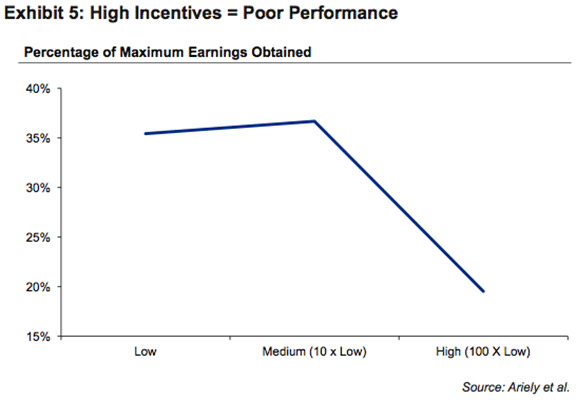
From the collected evidence on the psychology of incentives, it appears that when incentives get too high people tend to obsess about them directly, rather than on the task in hand that leads to the payout. Effectively, high incentives divert attention away from where it should be.
One of the other features that stands out as having changed significantly between the era of managerialism and the era of SVM is the lifespan of a company and the tenure of the CEO. Both have shortened significantly.
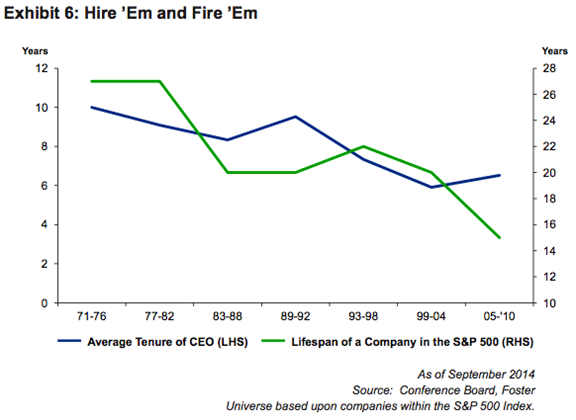
In the 1970s, the average lifespan of a company in the S&P 500 was 27 years (already down massively from the 75 years seen in the 1920s!). In the latter half of the last decade, the lifespan of a corporate in the S&P 500 had declined still further to a paltry 15 years.
In parallel to this trend, the average tenure of a CEO has fallen sharply as well. In the 1970s, the average CEO held his position for almost 12 years. More recently this has almost halved to an average tenure of just six years. It is little wonder that CEOs may be incentivized to extract maximum rent in the minimum time possible given the shrinkage of their time horizons (not independent of the shrinkage in time horizons for investors perhaps).
SVM and the Damage Done*
*With apologies to Neil Young.
Let’s now turn to the broader implications and damage done by the single-minded focus on SVM. In many ways the essence of the economic backdrop we find ourselves facing today can be characterized by three stylized facts: 1) declining and low rates of business investment; 2) rising inequality; and 3) a low labour share of GDP (evidenced by Exhibits 7 through 9).
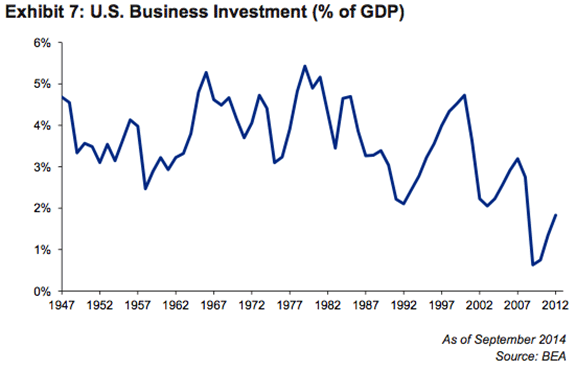
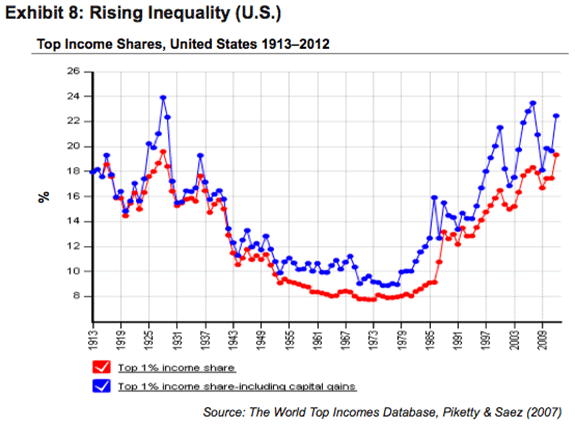
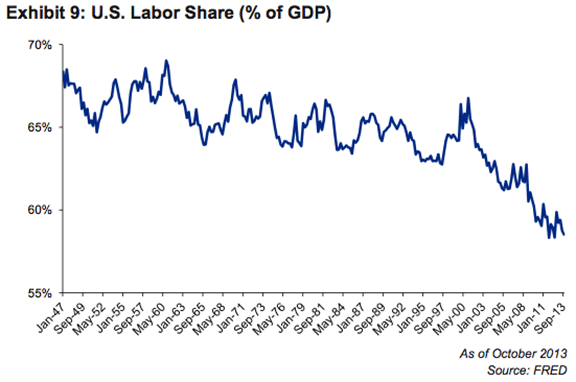
I’m going to argue that SVM has played a role in each of these characteristics. That isn’t to say that SVM alone is responsible, rather it is part of broader set of policies that have magnified these effects, but these are beyond the scope of this paper.
(In my opinion, SVM is part of the quartet of neoliberal policies that have led to the current economic situation. The others include the abandonment of full employment and its replacement with inflation targeting, globalization, and drive towards so-called flexible labour markets. I intend to return to these other policies in future notes. It is important to realize that all of these are policy choices; in as much as they are behind what has been called “secular stagnation” I’d argue that the outcome is itself a policy choice.)
Let me now turn to describing how SVM has played a significant part in generating these stylized facts. We will start with low and declining rates of business investment.
Given the shortening lifespan of a corporate and the decreasing tenure of the CEO, the finding that many managers are willing to sacrifice long-term value for short-term gain probably shouldn’t be a surprise. Nonetheless, an insightful survey of chief financial officers (CFOs) was conducted by John Graham et al. in 2005. They asked CFOs the following question: “Your company’s cost of capital is 12%. Near the end of the quarter, a new opportunity arises that offers a 16% internal rate of return and the same risk as the firm. The analyst consensus EPS estimate is $1.90. What is the probability that your company will pursue this project in each of the following scenarios?” The scenarios were based on how far short of expectations taking the project would leave quarterly EPS. Exhibit 10 shows the results.
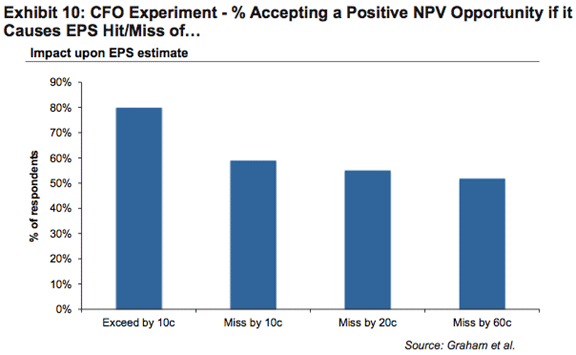
If they take the project and exceed the earnings estimate, 80% would willingly invest (which obviously leaves you wondering about the other 20%!) However, a miss of even 10c reduced this from 80% to 59%. By the time the miss was at 60c short of expectations, only approximately half of the CFOs would invest in the project.
More evidence of the pernicious impact of SVM can be found in a recent study conducted by Asker et al. (2013). They compared the investment rates of public (listed) and private (unlisted) companies. Asker et al. uncovered the startling fact that when one compares the two groups (controlling for size and stage of the life cycle) “the average investment rate among private firms is nearly twice as high as among public firms, at 6.8% versus 3.7% of total assets per year.”
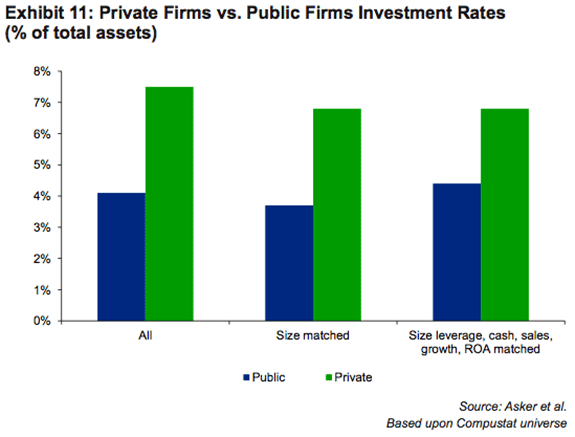
This preference for low investment tragically “makes sense” given the “alignment” of executives and shareholders. We should expect SVM to lead to increased payouts as both the shareholders have increased power (inherent within SVM) and the managers will acquiesce as they are paid in a similar fashion. As Lazonick and Sullivan note, this led to a switch in modus operandi from “retain and reinvest” during the era of managerialism to “downsize and distribute” under SVM.
Evidence of the rising payout amongst nonfinancial firms can be found in Exhibit 12. As one would expect under SVM, we have witnessed a marked increase in payouts over time. In the era of managerialism, somewhere between 10% and 20% of cash flow was regularly returned to shareholders. Under the rule of SVM this has risen significantly, reaching 50% of cash flows just prior to the Global Financial Crisis.

This diversion of cash flows to shareholders has played a role in reducing investment. A little known fact is that almost all investment carried out by firms is financed by internal sources (i.e., retained earnings). Exhibit 13 shows the breakdown of the financing of gross investment by source in five-year blocks since the 1960s. The dominance of internal financing is clear to see (a fact first noted by Corbett and Jenkinson in 1997).
From the mid 1980s onwards, equity issuance has been net negative as firms have bought back an enormous amount of their own equity (and geared themselves by issuing debt – a massive debt for equity swap). One of the most common raison d’êtres for stock markets that gets offered up is that they are providing vital capital to the corporate sector – the evidence suggests that this is nothing more than a fairy tale. Far from providing capital to the corporate sector,8 shareholders have been extracting it from corporates.
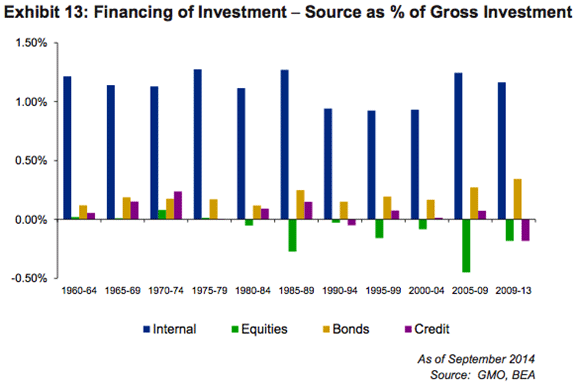
Now, if one were feeling charitable, one might choose to suggest that there just weren’t many new investment opportunities, and thus this return of capital was a perfectly reasonable thing to do. If this were the case, one might hope that the buybacks were done at prices that were below intrinsic value (since this would have genuinely improved the lot of shareholders). However, as Exhibit 14 shows, this hasn’t been the case. When market valuations were high (prior to the financial crisis) a record number of buybacks were conducted. Conversely, at the market lows, firms were hardly doing any buybacks at all. As Warren Buffett said in his letter to shareholders back in 1999, “Buying dollar bills for $1.10 is not a good business for those who stick around.”

The obsession with returning cash to shareholders under the rubric of SVM has led to a squeeze on investment (and hence lower growth), and a potentially dangerous leveraging of the corporate sector.
To see how this is related to the rising inequality that we have seen it is only necessary to understand who benefits from a rising stock market (i.e., who gets the “benefits” of SVM and its buyback frenzy). The identity of this group is revealed in Exhibit 15. The top 1% own nearly 40% of the stock market, and the top 10% own 80% of the stock market. These are the beneficiaries of SVM.
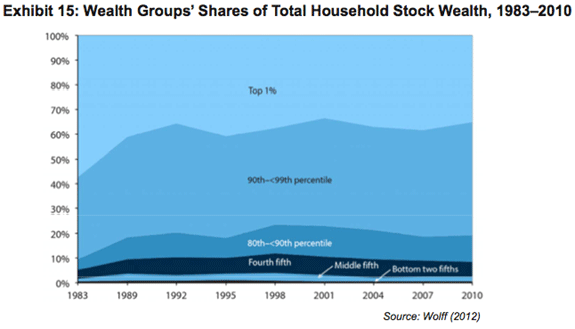
Another reflection of the role of SVM in creating inequality can be seen by examining the ratio of CEO-to-worker compensation. Before you look at the evidence, ask yourself what you think that ratio is today and what you think is “fair.” A recent study by Kiatpongsan and Norton (2014) asked these exact questions. The average American thought the ratio was around 30x, and that “fair” would be around 7x.
The actual ratio is shown in Exhibit 16. It turns out the average American was off by an order to magnitude! If we measure CEO compensation including salary, bonus, restricted stock grants, options exercised, and long-term incentive payouts then the ratio has increased from 20x in 1965 to a peak of 383x in 2000, and today sits somewhere just short of 300x!

We can see this has been a driving force behind the rise of the 1% thanks to a study by Bakija, Cole, and Heim (2012). The rise in incomes of the top 1% has been driven largely by executives and those in finance. In fact, executives and those in finance accounted for some 58% of the expansion of the income for the top 1%, and 67% of the increase in incomes for the top 0.1% between 1979 and 2005. Thus, there can be little doubt that SVM has played a major role in the increased inequality that we have witnessed.
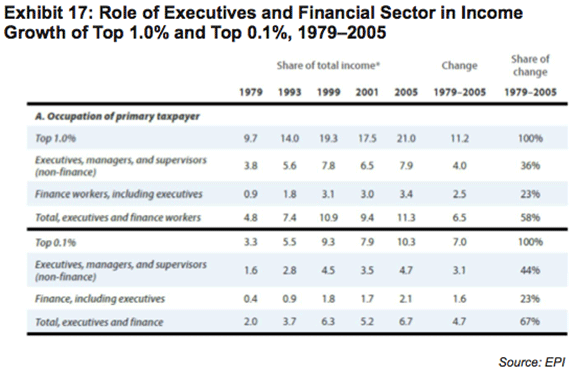
This makes the decline in the labour share even more dramatic for those outside of the top 1%. Exhibit 9 includes the top 1%, so if we were to exclude them the share of GDP going to the rest of labour would be even lower. In fact, if we look at the bottom 90% we would see their labour share of GDP going from around 42% in the late 1940s to approximately 27% today.
If one looks at the income gains during expansions as Pavlina Tcherneva (2014) has done, one will find that during the last two expansions the income gains have gone entirely (and most recently more than entirely) to the top 10%.
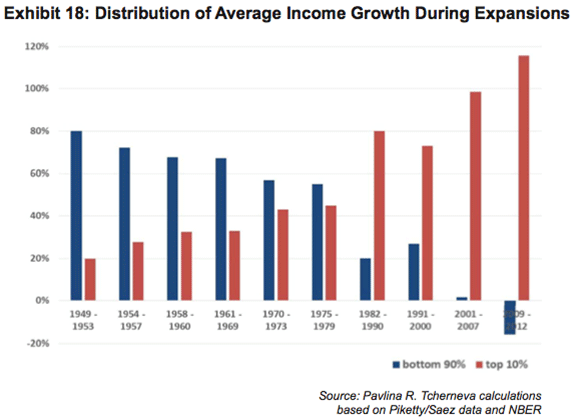
The problem with this (apart from being an affront to any sense of fairness) is that the 90% have a much higher propensity to consume than the top 10%. Thus as income (and wealth) is concentrated in the hands of fewer and fewer, growth is likely to slow significantly. A new study by Saez and Zucman (2014) provides us with the final exhibit in this essay. It shows that 90% have a savings rate of effectively 0%, whilst the top 1% have a savings rate of 40%.
The role of SVM in declining labour share should be obvious, because it is the flip-side of the profit share of GDP. If firms are trying to maximize profits, they will be squeezing labour at every turn (ultimately creating a fallacy of composition where they are undermining demand for their own products by destroying income).
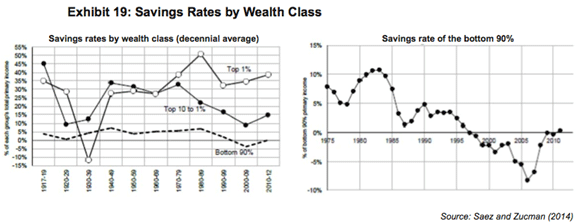
Conclusions
So what is one to conclude from this tirade? Three things stand out to me, each addressing a different constituency:
Shareholder’s Lesson
Firstly, SVM has failed its namesakes: it has not delivered increased returns to shareholders in any meaningful way, and may actually have led to poorer corporate performance!
Corporate’s Lesson
Secondly, it suggests that management guru Peter Drucker was right back in 1973 when he suggested “The only valid purpose of a firm is to create a customer.” Only by focusing on being a good business are you likely to end up delivering decent returns to shareholders. Focusing on the latter as an objective can easily undermine the former. Concentrate on the former, and the latter will take care of itself. As Keynes once put it, “Achieve immortality by accident, if at all.”
Everyone’s Lesson
Thirdly, we need to think about the broader impact of policies like SVM on the economy overall. Shareholders are but one very narrow group of our broader economic landscape. Yet by allowing companies to focus on them alone, we have potentially unleashed a number of ills upon ourselves. A broader perspective is called for. Customers, employees, and taxpayers should all be considered. Raising any one group to the exclusion of others is likely a path to disaster. Anyone for stakeholder capitalism?
Mr. Montier is a member of GMO’s Asset Allocation team. Prior to joining GMO in 2009, he was co-head of Global Strategy at Société Générale. Mr. Montier is the author of several books including “Behavioural Investing: A Practitioner’s Guide to Applying Behavioural Finance; Value Investing: Tools and Techniques for Intelligent Investment”; and “The Little Book of Behavioural Investing.” Mr. Montier is a visiting fellow at the University of Durham and a fellow of the Royal Society of Arts. He holds a B.A. in Economics from Portsmouth University and an M.Sc. in Economics from Warwick University.
Like Outside the Box?
Sign up today and get each new issue delivered free to your inbox.
It's your opportunity to get the news John Mauldin thinks matters most to your finances.
John Mauldin Archive |
© 2005-2022 http://www.MarketOracle.co.uk - The Market Oracle is a FREE Daily Financial Markets Analysis & Forecasting online publication.



